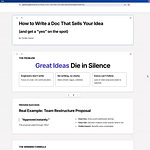This workshop is part of the Plan and scope like a data product manager playlist. Click here to explore the full series.
Quick note for you
I am running a live group coaching session on the 25th of November. If you want me to tackle your situation on the call, send your question upfront.
I read every submission before the session. It helps me give sharper answers instead of vague advice.
These calls work best when people show up with real problems. It also helps everyone learn who is in the community and what they struggle with.
Last time a cross-team project exploded on me, nobody argued about SQL. People argued about reality. Revenue in the BI tool said one thing. Revenue in a finance Excel said something else. RevOps had a third version in a private sheet. Every meeting turned into a group therapy session.
I remember one board cycle where I spent hours every week in “alignment calls”. We kept asking a simple question. Which number do we send to the board?
I was a senior data person on paper. In practice I felt like a human diff tool. When I finally snapped, I realised something simple. I did not need more meetings.
I needed one thing. Clear ownership for every step in the flow. So I pulled out an old tool from project management land and used it in anger.
It felt boring. Then it saved my ass.
Why cross-team projects blow up
You and I know how this goes. You join a “strategic” project. Everyone sounds excited. Product wants usage dashboards. Marketing wants funnel numbers. Finance wants clean ARR. Revenue wants something yesterday. You write notes. You draw diagrams. You fire up dbt.
Two weeks later, confusion hits. Someone created a parallel spreadsheet. Names for the same metric drift. Stakeholders ping you with “quick questions”.
You wake up inside three Slack threads and five side projects. Here is what really happened. You never froze who owns what. You never agreed who gives input. You never agreed who only gets updates.
So work leaks. Decisions drag. You look busy, yet nothing big lands. I lived inside this loop for years. When I finally forced myself to sit down and map roles, the change felt stupidly strong. Same tools. Same team. New clarity.
The simple tool I use
RACI sounds like corporate soup. I use it in a very blunt way. For every task in a project I pick four types of people.
Responsible are the folks who do the work.
Accountable is the single person on the hook if things fail.
Consulted are people who give input when needed.
Informed are people who only get updates.
I use names. Not “Analytics”. Not “Product”. Not “Leadership”. Just humans I can DM. When I adopt this into a project, I see a weird thing:
Meetings shrink.
Escalations drop
Slack turns quieter.
Because every time someone asks “who owns this”, I point to one name. Not a team. Not a job title. One person.
You may feel this sounds rigid. In practice it feels like air. No more shared ownership. No more “we thought someone else would pick it up”. Only clear roles.
The playbook from the workshop
In the workshop video above I walk through this playbook in detail with a migration example. Here is the text version for you. Use it on your next messy cross-team project.
Step 1: Map the project from idea to value
I start with a blank page and a simple question. From first request to real business value, which stages do we pass? For a data project it often looks like this. Align on outcome. Source and pipelines. Modeling. Consumption. Cutover. Follow-up.
I write those as big rows in a doc. I do not worry about tools yet. I want to see how value flows through the system.
Step 2: List concrete deliverables
Inside each stage I list specific outputs. Not “improve data quality”. Something I can point at. For example:
“Signed off KPI spec for ARR, MRR, churn”
“Source connector from CRM to warehouse live and tested”
“First version dbt model merged to main”
“Dashboard reviewed and accepted”
“Slack announcement with link and short Loom”
“Old Excel report archived”
Each line becomes a row in my future RACI. This is where scope creep dies early. If a stakeholder wants work outside this list, we talk. I either add a new line. Or I say no and explain why. When I skip this step, things always spiral. When I do it, I sleep better.
Step 3: Attach names with RACI
Now I create a simple table. Rows are deliverables. Columns are people. I mark each with R, A, C, or I. Key rules. Only one A per row. At least one R. C and I are optional. Names, not teams.
I run this exercise live in a kick-off call. When someone says “our team owns this”, I ask “who from your team”. When someone wants to sit in every column, I push back. You cannot be responsible, accountable, consulted, and informed for everything. You will block the team.
Once the group agrees, I pin the sheet in a shared channel. From that moment, this thing becomes my shield. Stakeholders come and go. Ownership does not move without a conversation.
Step 4: Use it in real life
RACI only works when you pull it into your daily work. When a new request pops up, I check which deliverable it touches and ping the person with A.
When someone argues about a metric, I look at the row for metric definition and bring in the A and C people. When something slips, I open the sheet, find the line, and talk to the A.
Over time people learn the pattern. They start to respect scope. They route questions to the right person. They realise you run the project like a system, not a hero show.
Listen to this episode with a 7-day free trial
Subscribe to Data Gibberish to listen to this post and get 7 days of free access to the full post archives.







